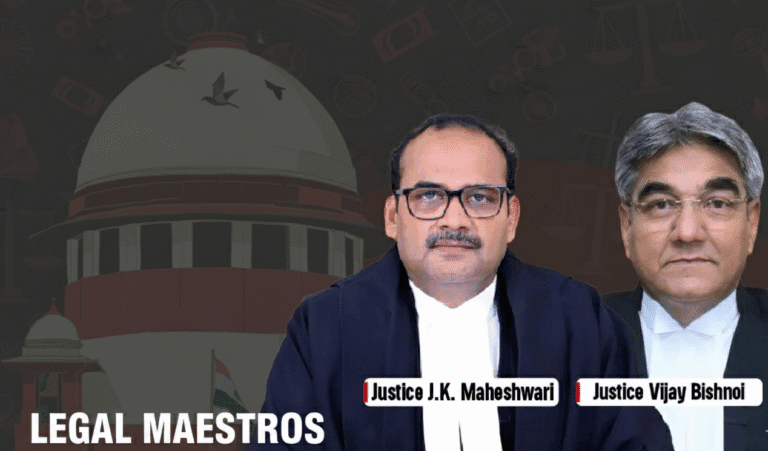
Section 302 Indian Penal Code 1860 Murder Charge and Punishment
Introduction
Padman Bihar was found guilty of murder and causing the loss of evidence under Section 302 and Section 201 of the Indian Penal Code, 1860, respectively, by a trial court on April 15, 2024.
The verdict was upheld by the Orissa High Court to the same extent. On May 21, 2025, the Supreme Court of India issued its final verdict after granting special permission to the court throughout the process.
For any queries or to publish an article or post or advertisement on our platform, do call at +91 6377460764 or email us at contact@legalmaestros.com.
By overturning the conviction, the Court brought attention to the inviolable rule that criminal guilt must be proven beyond a reasonable doubt, including in situations that are predicated on circumstantial evidence.
The Reality of the Situation
For the purpose of taking a bath, young Akash Garadia, together with his two companions Budhadeba and Susanta, went to a riverside close to his hamlet in the beginning of April in the year 2016. Subsequently, the appellant became a member of the group and proposed the idea of gathering cashew nuts from a field in the vicinity.
His father and the other villagers were concerned when Akash did not come home, and they searched the riverside and the fields, but they could not find anything. The corpse of Akash was found floating in the river the next day, which led to the filing of a First Information Report, which accused the appellant of killing Akash and destroying evidence.
During the course of the inquiry, the police found a stone that was smeared with blood close to the corpse; nevertheless, they did not record any statements or seizures at the appellant’s request.
The legal provisions that were invoked
Section 302 of the Indian Penal Code, which stipulates the penalty for murder, and Section 201 of the same code, which punishes the purposeful removal or destruction of evidence after the commission of a crime, were the charges that were brought against the appellant by the trial court.
A sentence of life imprisonment or death is authorized under Section 302, whereas a sentence of up to seven years in jail is authorized by Section 201. In accordance with these criteria, the courts below considered the combination of the last-seen testimony and the seizure of a possible weapon to be adequate grounds for sending a conviction.
For More Updates & Regular Notes Join Our Whats App Group (https://chat.whatsapp.com/DkucckgAEJbCtXwXr2yIt0) and Telegram Group ( https://t.me/legalmaestroeducators )
The findings of the defense and the trial court
The appellant denied any misconduct and argued that there was a false inference throughout the trial. There were eighteen witnesses for the prosecution who testified. These witnesses included independent eyewitnesses who saw him with Akash before he disappeared, family members who described searches, and the autopsy surgeon who certified that the deceased had been killed by a skull fracture.
The circumstances of the last-seen together and the closeness of the weapon established a comprehensive chain of evidence, according to the conviction handed down by the trial court. It was agreed upon by the High Court, which emphasized that the evidence as a whole led to the appellant’s having committed the crime.
The Review of the Supreme Court
A new investigation of the evidence was carried out by the Supreme Court, with the primary emphasis being on determining whether or not the chain of circumstantial evidence satisfied the strict criteria that had been imposed by precedent.
Additionally, the bench, which was led by Justices Karol and Mishra, reaffirmed that criminal convictions cannot be based on suspicion, regardless of how strong it may be, and that “last-seen together” alone is inherently weak unless it is bolstered by additional facts that incriminate the defendant.
Evidence on the basis of circumstantial evidence and the Golden Principles
In the case of Sharad Birdhichand Sarda v. State of Maharashtra, the Supreme Court emphasized the five golden principles for circumstantial cases.
These principles are as follows: the circumstances must be fully established; they must be conclusive in nature; they must point exclusively to the guilt of the accused; they must exclude other hypotheses; and the chain of evidence must be so complete that it leaves no room for reasonable doubt.
Based on the fact that the sole direct relationship was the appellant’s attendance with the dead on the day of the tragic event, the Supreme Court determined that these requirements were not satisfied.
Examining the Theory of the Last Sighted
In order to establish “last seen together,” there must be a short period of time between the time the accused was seen with the victim and the time the victim was discovered dead. This makes it very difficult for a third party to intercede in the situation. There was a lack of consensus among witnesses on the actual moment and location of the deadly act, and neither of them reported having seen the deed itself. In addition, the fact that the appellant did not flee or hide himself, as well as his readiness to participate in searches, rendered any suggestion of guilt inadmissible.
Both the Motive and the Weapon Play a Role
This story surfaced only during trial from a single witness whose version was not recorded by police earlier, but the Supreme Court acknowledged that the High Court accepted a conjectured motivation based on a family quarrel. However, the Supreme Court did emphasize that this narrative appeared only during trial.
The stone that was used in the alleged murder was discovered to have no connection to the appellant, according to any admission or recovery note. As a result of the chemical examination, blood was found on the stone; however, there was no blood-group match that could link it to the victim. Due to these gaps, it was not possible to establish a chain of evidence that was uninterrupted.
Identifying the Difference Between Suspicion and Proof
In the case of Sujit Biswas v. State of Assam, the Supreme Court decided that not even the most serious suspicions may serve as a replacement for evidence. The Supreme Court of the United States decided that the phrase “may be true” does not mean “must be true,” particularly in situations when the mental space between hypothesis and assurance is still rather large. Due to the fact that all other options were not definitively ruled out, reasonable doubt continued to exist.
The Most Important Concerns Regarding a Fair Trial
The court emphasized that in order to ensure a fair trial, circumstantial evidence must be subjected to very thorough examination. When it comes to addressing each damning truth, the right to know and answer the case against oneself extends to confronting all of the facts. Despite the fact that the appellant was not explicitly interrogated on a number of inconsistencies, the police failed to record important remarks. As a result of these deficiencies, faith in the prosecution’s story was diminished.
Reinforcement of Previous Examples
The Court relied on Kanhaiya Lal v. State of Rajasthan and Rambraksh @ Jalim v. State of Chhattisgarh to indicate that convictions based only on “last-seen” without corroboration are unconstitutional. It further referenced Bodhraj v. State of Jammu & Kashmir to emphasize that the temporal gap must be limited and the conditions must make third-party participation improbable. The Supreme Court’s concordance with these judgments confirmed a cautious approach to circumstantial cases.
Judgment and Acquittal
As a conclusion to its investigation, the Supreme Court came to the conclusion that the evidence was sufficient to provoke suspicion but did not show guilt beyond a shadow of a doubt. The appeal was granted, the convictions according to Sections 302 and 201 of the Indian Penal Code were overturned, and the appellant was ordered to be released. The Court emphasized that in situations when there is a lack of clarity, acquittal is necessary in order to protect individual liberty.
The Finalization
The conviction in the case of Padman Bihar underlines the fundamental concept that criminal law requires evidence that is beyond all reasonable question required. By examining the sufficiency of circumstantial evidence and reiterating the golden standards, the Supreme Court safeguarded the right to a fair trial and shown that even strong suspicions are not sufficient to support conviction. This ruling serves as an important reminder that the authority to prevent someone from exercising their freedom must be utilized with the greatest caution and clarity.







